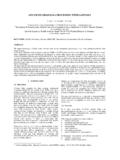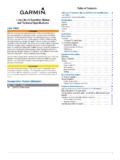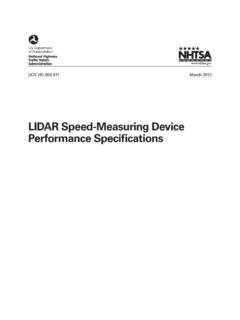Transcription of Using LiDAR Data to Create InRoads SS2 Digital …
1 Version 1. 03/16/2018. State of Connecticut Department of Transportation, AEC Applications Division of Facilities & Transit Using LiDAR Data to Create InRoads SS2 Digital Terrain Models The SELECTS eries Digital Design Environment Table of Contents Section 1 Introduction ..2. Required Versions .. 2. Workflow Description .. 2. File 2. Flow Chart .. 3. Section 2 LiDAR Data Retrieving LiDAR Data from 4. Downloading and Saving the LiDAR Data 9. Section 3 Point Clouds .. 10. Creating a 3D DGN File .. 10. Creating Point Clouds from LiDAR Data .. 12. Point Cloud Display .. 14. Section 4 Point Reduction Methods .. 15. Reducing the Area and Density of POD Files .. 16. Area 16. Density Reduction.
2 17. Data Acquisition Filter Descriptions .. 18. Section 5 InRoads Surface Tools .. 20. Using Data Acquisition .. 20. Creating an InRoads DTM .. 22. Displaying InRoads DTM Graphics .. 23. Section 6 Appendix .. 26. More about Point Clouds .. 26. When and Why Should Points be Reduced .. 27. Page 1 of 31. Section 1 Introduction Required Versions MicroStation V8i (SELECT series 4) - Version InRoads V8i (SELECT series 2) - Version Workflow Description This Workflow was developed for use with network drives (X-Drive) projects to instruct designers on how to retrieve 2016 LiDAR data from the online NOAA Data Access Viewer to Create an InRoads SS2 Digital terrain model (DTM). Prerequisites for Using this workflow include basic MicroStation and InRoads knowledge.
3 File Formats Statewide LiDAR can also be found in several locations. Keep in mind file formats found on websites might not be compatible with MicroStation V8i. Statewide LiDAR compatible with MicroStation V8i can be found in two places. NOAA website - 2016 Flight, available at #/ LiDAR /search/ Data is retrieved and downloaded from the website and then imported into a MicroStation Point Cloud POD. file. ProjectWise 2004 Flight, available through the Aerial Tools Application that runs inside of MicroStation and gets attached as a MicroStation Point Cloud POD file. Known Locations of Connecticut LiDAR Data Combatable with MicroStation V8i ProjectWise Statewide 2004. 5 FT Point Clouds YES.
4 NOAA Website 2016 CRCOG LiDAR : Connecticut Statewide Points ASCII X,Y,Z Pts YES. 2016 CRCOG LiDAR : Connecticut Statewide Points - LAS NO. 2016 CRCOG LiDAR : Connecticut Statewide Points - LAZ NO. UCONN/CT ECO. Statewide 2016. DEM NO. Statewide 2016. LAS NO. Page 2 of 31. Flow Chart RETRIEVE DOWNLOAD Create IMPORT. DATA DATA DGN DATA. Create Create . TERRAIN InRoads . SS2 DTM. POINT. REDUCTION. OPTIONAL. Page 3 of 31. Section 2 LiDAR Data Retrieval Retrieving LiDAR Data from NOAA. 1 . Go to the NOAA Data Access Viewer and search for your location. #/ LiDAR /search/. 2 . After entering a location or address the viewer may make the map zoomed in too far, you may need to zoom out a bit to see the map information.
5 Page 4 of 31. 3 . Click the Draw Search Area icon. Click and drag from left to right to Create a selection area. The area should be shaded. 4 . To select a data set, click the Cart icon next to the 2016 CRCOG LiDAR : Connecticut Statewide data set title. The cart icon in the upper right should update and show the number of items added. Page 5 of 31. 5 . Click on the shopping cart icon. The MY CART page should appear, the data source you selected should be shown. Click Next. Page 6 of 31. 6 . The next page shows projection options. Set the Projection, Datum and Unit fields to those matching your survey ground file, if you do not have a survey file select NAD83 and NAVD88. Set the Output Options: Output Product: Point Output Format: Points ASCII X,Y,Z Pts.
6 Then Click Next. NOTE: If your survey is Horizontal Datum NAD27 and Vertical Datum NAVD88 extra steps will need to be completed in MicroStation as this is not an option on the NOAA website as it is a rare occurrence. In this case select the Vertical Datum NGVD29 and see AEC Applications for help with the vertical transformation. Page 7 of 31. 7 . On the next page enter your state email address. Click Next. 8 . Review your selections and if correct, click Submit. 9 . Take note of the order number provided on the confirmation page and make a note for the location, this will make it easier to sort out emails received later with the data links. Page 8 of 31. Downloading and Saving the LiDAR Data Set 1.
7 The first email you receive from Digital Coast is a confirmation of the data request. No action needs to be taken with this email. The second email contains the download link (keep in mind this link will eventually expire) for the data. Click the link in the email and save the zip file to your project. The third email you receive also contains links to the same data in the second email. This email can be ignored. Emails may take a few minutes to receive; your wait time will be longer for larger data sets. 2 . After clicking the link, Select Save as. Browse to your project folder and the appropriate subfolder for your unit. Click Save. 3 . In window explorer select the zip file, right click and choose Extract All.
8 The files will extract into a folder and contain a .txt file(s) and an .xml file. 4 . Erase the zip file once the files are extracted, once the files are unzipped the zip version is not needed. Page 9 of 31. Section 3 Point Clouds In this section you will Create a 3D MicroStation file used for the LiDAR data import. This DGN file will be used to pull the LiDAR data in to a Point Cloud MicroStation POD file. Creating a 3D DGN File 1 . Open MicroStation through accounting. Do not use an existing file that has elements already in it, this could slow the processing up when an InRoads DTM is getting created and displayed. 2 . Create a brand new 3D MicroStation file Using the correct seed file.
9 Select the 3D geospatial seed file that matches your datum from the following path W:\Workspace\Standards\seed\Geospatial\. Follow the prompts to name and open the new file. 3 . On the MicroStation main menu select Tools > Geograghic > Select Geographic Coordinate System. On the Geograghic Coordinate sytem tool box select Edit Reprojection Settings. Page 10 of 31. 4 . On the Reprojection Settings dialog box set Reproject Elevations to Yes on both the Reference and Active Model tabs. 5 . If you downloaded a 1983 State Plane data set with NAD83 horizontal information and chose a vertical datum of NGVD29 (rather than the typical NAVD88) you will need to adjust the Vertical Datum setting in MicroStation before importing the points.
10 A. On the MicroStation main menu select Tools >Geograghic > Select Geographic Coordinate System. On the Geograghic Coordinate sytem tool box select Details. B. On the Geoghraghical Coordinate System Properties dialog box change the Vertical Datum to National Geodetic Vertical Datum of 1929 and select OK. Page 11 of 31. C. On the Geographic Coordinate System Changed dialog box select Reproject the Data to the new Geographic Coordinate System and select OK. D. On the MicroStation main menu select File > Save Settings. Creating Point Clouds from LiDAR Data 1 . In MicroStation select the Point Clouds Icon. 2 . The Point Clouds dialog will appear, Click the Attach button. 3 . Windows Explorer dialog box will appear, browse to select the text files that were downloaded from the NOAA site.















